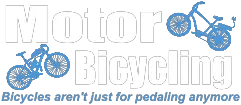msrfan,
I was thinking along the lines of a dampener as well... something to slow down the steering.
I remember the first time I test road my American Flyer with the canoe sidecar... wasn't going fast at all and nearly ran into a tree. It was awful getting used to it and I did not think I liked it at all. My brain understood that I had to turn the handlebar in order to turn, but my body wanted to do it as I had without the sidecar... mostly leaning into a curve. With three wheels leaning doesn't work. It took awhile getting the hang of it. Sounds simple, but it involves the intelligence of the body unlearning one thing and learning another. It isn't that the sidecar rig is better than or worse than... more a matter of different than and has it's own set or "rules".
The setup you describe, Dale, sounds like it could be safe enough at moderate speed, but there would be a learning curve and a person who had never ridden a two or three wheeled bike before might get the hang of it quicker than you or me.
I hope someone pursues this so we can all find out how well or poorly it works. Not me; I have too many unfinished builds as it is.
SB














